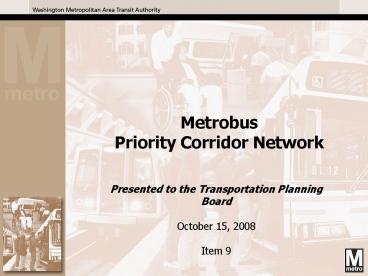Presented to the Transportation Planning Board - PowerPoint PPT Presentation
1 / 10
Title:
Presented to the Transportation Planning Board
Description:
Metrobus has 171 lines with total daily ridership of 450,000 ... 220,000 current daily riders. 70 million annual riders. 246 line miles of service ... – PowerPoint PPT presentation
Number of Views:95
Avg rating:3.0/5.0
Title: Presented to the Transportation Planning Board
1
Metrobus Priority Corridor Network
Presented to the Transportation Planning
Board October 15, 2008 Item 9
2
Proposed Priority Corridor Network
- Network of 24 corridors
- High ridership arterial services (half of system)
- Candidates for multiple types of services
- Selected by
- Performance
- Ridership
- Land use
- Service levels
- Jurisdictional support
- 6 Year Schedule
See slide 9 for listing of routes
3
Comprehensive Approach to Bus Service Improvement
- A Regional Priority Corridor Network Plan will
- Integrate service improvements, including new
MetroExtra routes - Improve performance of all routes in the corridor
- Coordinate stakeholder investments in stops,
roadway improvements and safety/security
strategies - Implementation
- Improves street operations to improve travel
times and reliability - Manages fleet and garage needs
- Enhances customer information
- Focus on Priority Corridors
- Benefits the most riders
- Improves service quality, reliability,
performance - Builds transit market and influences development
patterns
4
Characteristics of Priority Bus Corridors
- Metrobus has 171 lines with total daily ridership
of 450,000 - Corridors represent 14 of lines (50 of
ridership) - Recommended Priority Corridor Plans serve
- 220,000 current daily riders
- 70 million annual riders
- 246 line miles of service
- Corridors include
- Local Metrobus
- Express Metrobus
- MetroExtra (Rapid Bus)
- Neighborhood Shuttles
- Proposals add 10 million riders annually (14)
5
Priority Corridor Implementation Plan
6
Benefits
- Benefits half of Metrobus riders within six-year
time frame - Improves overall Metrobus customer service,
reliability, quality performance - Expands transit market and influences development
patterns in the region - Coordinates investments in stops, roadway
improvements and safety/security strategies
7
Regional Policy Initiatives
- Adoption of policies by stakeholder jurisdictions
reflecting their role in transit provision - Prioritization of person throughput over vehicle
throughput - Mode-shift incentives on major arterials
- Adoption of Transit First policies
- Incorporation of bus transit implementation
requirements into plans for transportation and
land-use projects. - Provision for strategic reservation of
right-of-way and maintenance facilities by local
land use plans.
8
The TPB Role
- The TPB can provide support of this Bus Priority
Corridor Plan by - Ensuring that related policy considerations are
discussed in various committees and forums
available to the TPB - Regional Bus Subcommittee
- Management and Operations Intelligent
Transportation Systems (MOITS) Task Force - Exploring strategies for acquiring additional
funding support for the capital improvements
included in the plan - Existing and future federal programs
- Regional pricing initiatives
- Partnering with stakeholders in the region to
develop implementation strategies - This could include convening meetings of regional
stakeholders to discuss policy considerations and
develop regional consensus on strategies needed
to insure success of the plan.
9
Recommended Priority Corridor Network
Schedule as of October 7, 2008, to be presented
to the WMATA Board on October 16.
10
Requested Emerging Corridors
- Corridors for future consideration as Priority
Corridor Network candidates. - Local concept development studies are to be
conducted to refine proposals for future
consideration before implementation as part of
WMATA plan.
10































